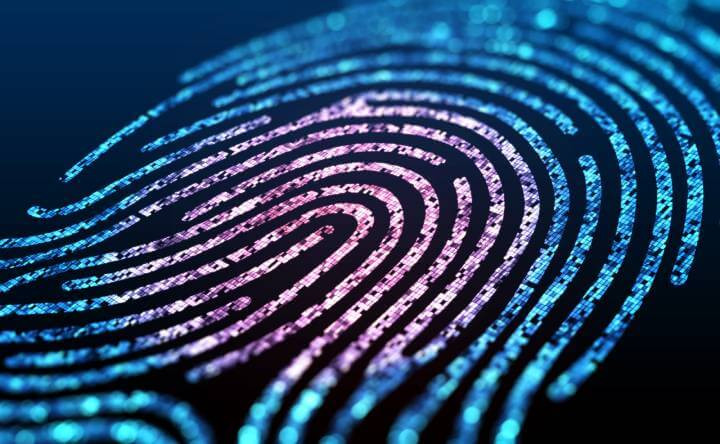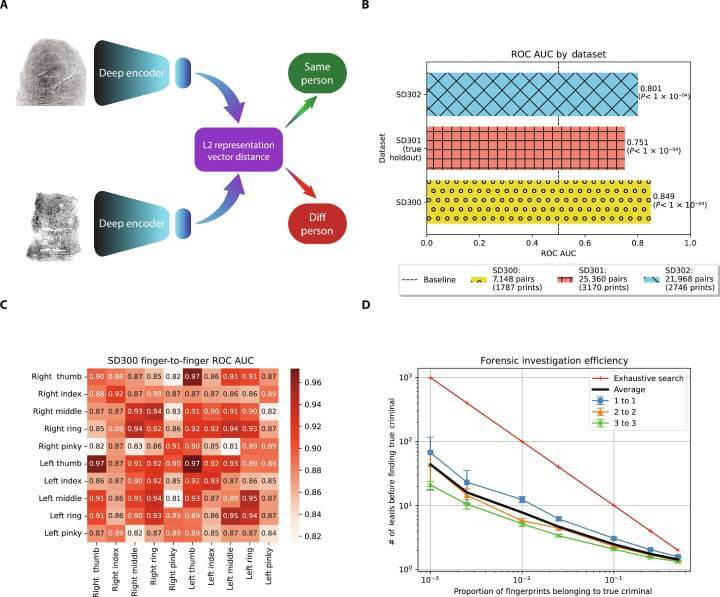AI Redefines Fingerprint Analysis: A Shift in Forensic Science
Insights | 31-01-2024 | By Robin Mitchell

Key things to know:
- AI's Impact on Forensics: Recent studies reveal AI can identify cross-finger similarities, challenging the long-held belief in the uniqueness of fingerprints.
- Research Breakthroughs: Columbia University's research demonstrates AI's ability to link fingerprints from different fingers to the same individual with high accuracy.
- Implications for Justice: This discovery could revolutionise forensic methodologies and potentially impact the use of fingerprints in legal proceedings.
- Technological Advancements: The integration of AI in forensic science signifies a significant shift towards more sophisticated, data-driven investigation techniques.
In a shocking discovery by researchers, fingerprints, which have always been touted as being entirely unique, may not be as unique as many believed, potentially challenging how fingerprints are used in court cases. Why have fingerprints been essential in the fight for justice, what did the researchers discover, and what does this mean for fingerprints in the realms of police work?
Recent advancements in artificial intelligence have led to groundbreaking findings that challenge the long-held belief in the uniqueness of fingerprints. A study conducted by Prof Hod Lipson and his team at Columbia University utilised deep learning to analyze fingerprints, revealing that prints from different fingers of the same person share significant similarities. This discovery, published in the prestigious journal Science Advances, suggests that the conventional methods of fingerprint analysis might need to be reevaluated in light of these new insights.
Why have fingerprints been essential in the fight for justice?
Before the introduction of modern forensics, those looking for justice would have to either catch a criminal in the act or resort to eyewitness testimony. However, without modern forensics utilising the scientific method to produce evidence, such a justice system can be easily manipulated, with false witness testimonies, statements, and outright corruption all tainting the process.
This was extremely common in the past when criminals were rarely given a fair trial, often being shamed and, in many cases, condemned by the public. A judge who faces social pressure or has some ulterior motive could easily ignore presented evidence, pass judgment, and present harsh sentences.
An excellent case of this would be the witch trials, whereby women who threatened men or refused their advances could be accused of being witches. Once accused, the resulting judgement would not come from a fair trial but through a popularity contest, and the penalty of death would ensure that the victim could never speak out.
Thankfully, due to the introduction of modern forensics and the scientific method, such practices are a thing of the past, and the justice system has never been fairer than it is today. Judgement can only be cast when strong evidence is presented, and even if a party is found guilty of a crime, the resulting sentence often reflects the degree of certainty in the guilt of the party. For example, someone who is found guilty of murder may not necessarily receive the maximum sentence if the murder cannot be proven beyond a reasonable doubt.
The Evolution of Forensic Evidence in Modern Justice
In this quest for fair trials, numerous technologies have arisen that help criminal prosecutors ensure that they are convicting the right individual, and these include DNA matching, particulates found at crime scenes, hair follicles, and CCTV. But one form of evidence has stood above the rest due to its ability to prove the presence of someone at a crime scene beyond reasonable doubt: fingerprints.
Because fingerprints are accepted as being unique to each individual, crime scene investigators can lift fingerprints from surfaces and find matches in criminal databases (as well as against those under suspicion). As it is extremely difficult to plant fingerprints (despite what TV shows depict), fingerprints found at a crime scene are an extreme indicator of someone’s involvement or, at the very least, presence.
The traditional approach to fingerprint analysis, focusing on minutiae such as ridge endings and bifurcations, has been a cornerstone of forensic science for decades. However, the AI-driven research by Columbia University's team points towards a different set of features that could be equally, if not more, indicative of individual identity. By examining the ridge patterns and their orientations, the AI was able to identify fingerprints from the same individual with a remarkable degree of accuracy, suggesting a potential shift in how forensic experts approach fingerprint analysis in the future.
AI discovers that fingerprints are not as unique as originally thought
In what can only be described as a major shock to the world of forensics, an AI developed by a team of researchers has recently demonstrated that it is possible to match fingerprints from different fingers to a single individual with a high degree of probability. In layman’s terms, it is now possible for AI to recognise fingerprints belonging to the same individual without prior knowledge.
Understanding the groundbreaking methodology behind the AI's ability to discern similarities across different fingerprints from the same individual is crucial. The following figure, Fig. 1, provides a comprehensive overview of the cross-finger similarity analysis pipeline and the remarkable results achieved by the research team. This visual representation elucidates the intricate process and the innovative approach adopted by the AI, offering a clear insight into how the technology challenges traditional notions of fingerprint uniqueness.
Fig. 1. Overview of cross-finger similarity analysis pipeline and results.

Fig. 1 offers an insightful overview of the cross-finger similarity analysis pipeline and its findings. In Panel (A), the deployment of twin neural networks for the examination and identification of cross-finger similarities is depicted, showcasing the innovative approach to fingerprint analysis. Moving to Panel (B), it is illustrated how our fingerprint representation vectors discern a statistically significant variance, as confirmed by one-sided paired t tests, between distinct fingerprint pairs such as the left index versus the right pinky, whether they originate from the same individual or different individuals, with further examples provided in figs. S1 to S3. Panel (C) extends this analysis, demonstrating that the cross-finger similarities, evaluated using ROC AUC (receiver operating characteristic—area under the curve), where a higher score indicates superior performance, are consistently observed across all possible finger pairings, even those from different hands, with results from SD300 and additional confirmation across datasets shown in fig. S4 and the statistical significance of these finger-by-finger similarities highlighted in fig. S5. Lastly, Panel (D) underscores the practical implications of our findings, showing that the established cross-finger similarities could significantly reduce the investigative workload in criminal justice settings by more than an order of magnitude, as evidenced by the means and SEM of a number of leads, with fig. S8B offering an alternate visualisation of this data, all while noting that our baseline comparison was an exhaustive search due to the lack of existing methods for cross-finger matching.
Detailed Analysis of Cross-Finger Print Similarities
The research project, conducted by researchers from Columbia University, wanted to establish what patterns and links could be found between different fingerprints by AI. Initially, it was believed that the AI would not be able to draw any significant links as fingerprints have been well-established as being entirely unique. what did the researchers discover, and what does this mean for fingerprints in the realms of police work
However, to the shock of the team, after training their AI on large datasets of fingerprints (utilising a public database provided by the US government), it was found that as more data was fed in, the AI was able to more accurately identify fingerprints that belonged to the same individual. According to the researchers, they believe that the AI was able to do this by looking at the shape of loops, folds, and the edges of fingers, thus suggesting that individual fingers have unique prints but a common shape and style to an individual.
The implications of these findings extend beyond the academic realm into practical applications in forensic science. The ability of AI to discern patterns across different fingerprints from the same individual could revolutionise the way criminal investigations are conducted, offering new avenues for linking evidence to suspects. This could be particularly transformative for cold cases or instances where partial prints are all that's available, potentially increasing the solvability of such cases significantly.
The end result of the AI was the ability to identify different fingerprints of an individual with an accuracy of around 90%. Recognising the significance of their findings, the researchers requested their findings be published in leading forensic journals but were initially refused. It was only until the researchers challenged this decision that the results were finally published.
What does this mean for fingerprints as evidence in police work?
Even though the AI is able to match different fingerprints to an individual, that doesn’t mean that fingerprints themselves are not unique. When forensic experts study fingerprints, they look for absolute patterns, with loops, folds, and marks needing to be in the exact same place, but in the case of the AI, it is more likely to look for similarities between fingerprints that indicate a specific individual.
This means that, for the time being, fingerprints are perfectly acceptable as evidence in a court of law. However, what the AI does introduce to criminal investigators is the ability to match different fingerprints either at the same crime scene or others.
For example, a fingerprint of an index finger at one crime scene can be matched to a thumbprint at another. While this wouldn’t be sufficient for evidence in court, it could potentially allow investigators to identify people of key interest. Once identified, obtaining an entire set of prints could then be used to confirm any matches, thus securing evidence.
Moreover, the BBC report on this study highlights the broader implications for biometric security and forensic science. The notion that fingerprints may not be as unique as previously thought could prompt a reevaluation of their use in security systems and legal proceedings. While fingerprints will continue to be a valuable tool for identification, this new understanding underscores the importance of adopting a multifaceted approach to biometric security, combining various methods to ensure robustness and reliability.
The technology could also be used in cold cases whereby prints are found but need to be matched to individuals in a database. For example, unknown fingerprints in one case could match up to another case, even if they are of different fingers, thereby establishing links between cases.
Overall, what the researchers have discovered introduces serious ramifications on how we think about fingerprints but could very well lead to new approaches in the pursuit of justice.

